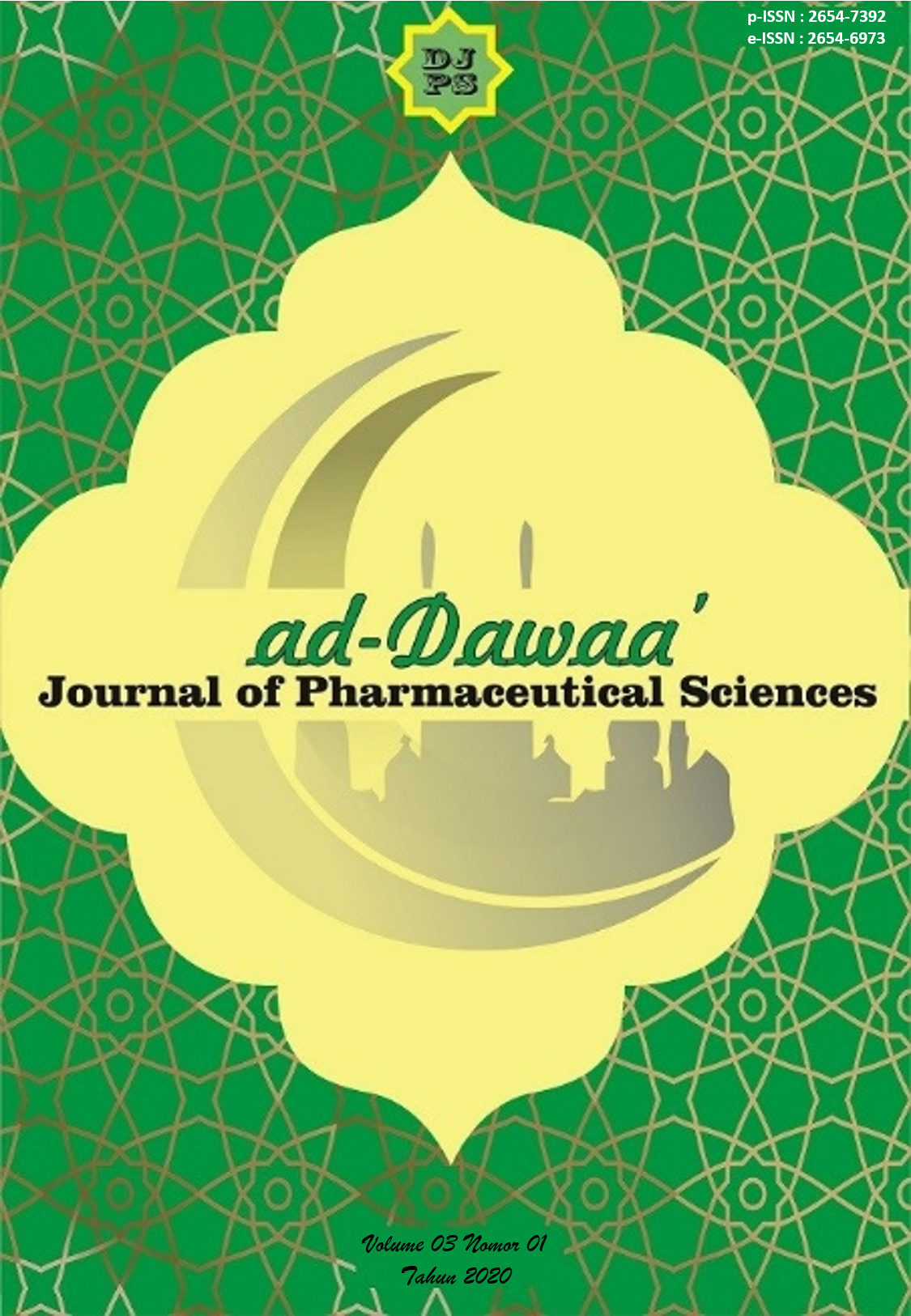Molecular Docking Study on COVID-19 Drug Activity of N-(2-phenylethyl)methanesulfonamide Derivatives as Main Protease Inhibitor
Abstract
The aim of this research is to find potential new compounds that are potential to be developed as COVID-19 drugs with a mechanism to inhibit the main protease (Mpro) enzyme from the COVID-19 virus. The method used molecular docking with the AutodockTools 1.5.6 program and continued with the prediction of pharmacokinetic profiles and toxicity with the help of the PreADMET application. Inhibition potential was assessed based on the binding energy value and the inhibition constant. Research showes that natural ligand (N-(2-phenyl-ethyl) methanesulfonamide), S1, S3, S7, and S9 were compounds that provide inhibitory activity against Mpro enzymes which were more potent than lopinavir as a comparison. The binding energy and inhibition constants of natural ligands, S1, S3, S7, and S9 are lower than comparative compounds, respectively -1.61 kcal/mol and 66.26 mM. ADMET prediction shows that these potential compounds still need improvement in terms of pharmacokinetics and toxicity.
Downloads
References
Ali, S., Mouton, C. D., Jabeen, S., Zeng, Q., Galloway, G., & Mendelson, J. (2013). Suicide, depression, and CYP2D6: How are they linked? Current Psychiatry, 12(5).
Ames, B. N., Gurney, E. G., Miller, J. A., & Bartsch, H. (n.d.). Carcinogens as frameshift mutagens: metabolites and derivatives of 2-acetylaminofluorene and other aromatic amine carcinogens. Proceedings of the National Academy of Sciences of the United States of America. doi:https://doi.org/10.1073/pnas.69.11.3128
Belouzard, S., Millet, J. K., Licitra, B. N., & Whittaker, G. R. (2012). Mechanisms of coronavirus cell entry mediated by the viral spike protein. . Viruses, 4(6), 1011-1033. doi:https://doi.org/10.3390/v4061011
Ding, Y., He, L., Zhang, Q., Huang, Z., Che, X., Hou, J., . . . Jiang, S. (2004). Organ distribution of severe acute respiratory syndrome (SARS) associated coronavirus (SARS‐CoV) in SARS patients: implications for pathogenesis and virus transmission pathways. The Journal of Pathology, 203(2), 622-630. doi:https://doi.org/10.1002/path.1560
Guo, Y., Korteweg, C., McNutt, M. A., & Gu, J. (2008). Pathogenetic mechanisms of severe acute respiratory syndrome. Virus Research., 133(1), 4-12. doi:https://doi.org/10.1016/j.virusres.2007.01.022
Hilgenfeld, R. (2014). From SARS to MERS: crystallographic studies on coronaviral proteases enable antiviral drug design. The FEBS Journal, 281(18), 4085-4096. doi:https://doi.org/10.1111/febs.12936
Hsu, M.-F., Kuo, C.-J., Chang, K.-T., Chang, H.-C., Chou, C.-C., Ko, T.-P., . . . Liang, P.-H. (2005). Mechanism of the maturation process of SARS-CoV 3CL protease. Journal of Biological Chemistry, 280, 31257-31266. doi:https://doi.org/10.1074/jbc.M502577200
Jo, S., Kim, S., Shin, D. H., & Kim, M.-S. (2020). Inhibition of SARS-CoV 3CL protease by flavonoids. Journal of Enzyme Inhibition and Medicinal Chemistry, 35(1), 145-151. doi:https://doi.org/10.1080/14756366.2019.1690480
Li, W., Moore, M. J., Vasilieva, N., Sui, J., Wong, S. K., Berne, M. A., . . . Farzan, M. (2003). Angiotensin-converting enzyme 2 is a functional receptor for the SARS coronavirus. Nature., 426(6965), 450-454. doi:https://doi.org/10.1038/nature02145
Lindner, H. A., Fotouhi-Ardakani, N., Lytvyn, V., Lachance, P., Sulea, T., & Ménard, R. (2005). The Papain-Like Protease from the Severe Acute Respiratory Syndrome Coronavirus Is a Deubiquitinating Enzyme. Journal of Virology, 79(24), 15199-151208. doi:doi: 10.1128/JVI.79.24.15199-15208.2005
Liu, X., & Wang, X.-J. (2020). Potential inhibitors against 2019-nCoV coronavirus M protease from clinically approved medicines. Journal of Genetics and Genomics, 47(2), 119–121. doi:https://doi.org/10.1016/j.jgg.2020.02.001
Ma, X.-l., Chen, C., & Yang, J. (2005). Predictive model of blood-brain barrier penetration of organic compounds. Acta Pharmacologica Sinica, 26, 500–512. doi:DOI: 10.1111/j.1745-7254.2005.00068.x
Potet, F., Lorinc, A. N., Chaigne, S., Hopkins, C. R., Venkataraman, R., Stepanovic, S. Z., . . . Kupershmidt, .. S. (2012). Identification and characterization of a compound that protects cardiac tissue from human Ether-à-go-go-related gene (hERG)-related drug-induced arrhythmias. , 287(47), . Journal of Biological Chemistry, 287(47), 39613–39625. doi:doi: 10.1074/jbc.M112.380162
Prajapat, M., Sarma, P., Shekhar, N., Avti, P., Sinha, S., Kaur, H., . . . Medhi, B. (2020). Drug targets for corona virus: A systematic review. Indian Journal of Pharmacology, 52(1), 56–65. doi:https://doi.org/10.4103/ijp.IJP
Schinkel, A. H. (1999). P-Glycoprotein, a gatekeeper in the blood-brain barrier. . Advanced Drug Delivery Reviews, 36(2-3), 179-194. doi:https://doi.org/10.1016/S0169-409X(98)00085-4
Stobart, C. C., Sexton, N. R., Munjal, H., Lu, X., Molland, K. L., Tomar, S., . . . Denison, M. R. (2013). Chimeric Exchange of Coronavirus nsp5 Proteases (3CLpro) Identifies Common and Divergent Regulatory Determinants of Protease Activity. Journal of Virology, 87(23), 12611-12618. doi:https://doi.org/10.1128/jvi.02050-13
Velthuis, A. J., Worm, S. H., & Snijder, E. J. (2012). The SARS-coronavirus nsp7+nsp8 complex is a unique multimeric RNA polymerase capable of both de novo initiation and primer extension. Nucleic Acids Research, 40(4), 1737–1747. doi:https://doi.org/10.1093/nar/gkr893
Yang, H., Bartlam, M., & Rao, Z. (2006). Drug Design Targeting the Main Protease, the Achilles Heel of Coronaviruses. . Current Pharmaceutical Design, 12(35), 4573 - 4590. doi:https://doi.org/10.2174/138161206779010369
Yee, S. (1997). In vitro permeability across Caco-2 cells (colonic) can predict in vivo (small intestinal) absorption in man - Fact or myth. Pharmaceutical Research, 14, 763–766. doi:https://doi.org/10.1023/A:1012102522787
Zhang, L., Lin, D., Sun, X., Rox, K., & Hilgenfeld, R. (2020). X-ray Structure of Main Protease of the Novel Coronavirus SARS-CoV-2 Enables Design of α-Ketoamide Inhibitors. . BioRxiv. doi:https://doi.org/10.1101/2020.02.17.952879
Once an article was published in the journal, the author(s) are:
- granted to the journal right licensed under Creative Commons License Attribution that allows others to share the work with an acknowledgement of the work's authorship.
- permitted to publish their work online in third parties as it can lead to wider dissemination of the work.
- continue to be the copyright owner and allow the journal to publish the article with the CC BY-SA license
- receiving a DOI (Digital Object Identifier) of the work.


1.png)